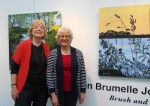Joanne Waters, left, and Karen Brumelle. (photo by Olga Livshin)
Karen Brumelle and Joanne Waters have much in common. They have been friends for more than 40 years. Both spent their childhood and young adulthood in the United States. Both came to Vancouver when their husbands started working at the University of British Columbia. Both are artists and have participated in multiple exhibitions. Both are inspired by nature. But they never exhibited together until now. Their show, Brush and Wire, is at the Sidney and Gertrude Zack Gallery until March 16.
The artists’ visual narrations complement each other, as Brumelle’s cheerful paintings of rivers and forests provide a quaint background for Waters’ wire sculptures of birds and sea creatures.
“You’re influenced by the place you live in,” Brumelle said, explaining her landscapes of local scenery. Color and line serve as her creative language, the vehicle of her love for her adopted land. “Everything I look at, I mentally put a frame around. I always wonder: what might make a good painting? I take lots of photographs but I don’t want photographic likeness. I want to simplify the images, find their emotional core. I am more concerned with portraying a spiritual essence.”
Orange leaves blaze on her autumn trees. The green flow of the Fraser River invites contemplations. What many Vancouverites see from their windows, Brumelle explores through brushstrokes, paper and scissors.
“Collages are more fun. They are spontaneous, a free exploration.”
In her collages, Brumelle combines paper shapes with painting. “Collages are more fun. They are spontaneous, a free exploration. The pattern of the paper often suggests the collage details. I collect papers, buy them wherever I travel. My collages are more abstract than my paintings but they’re also more playful.”
Perhaps the playfulness of her collages is an echo of her long career as an art teacher. Before she retired in 2004, she taught art at Arts Umbrella and other schools. For 10 years, she taught art at Lord Byng and loved it.
“When I was a teacher, I constantly tried to come up with new exercises for my students. I wasn’t painting as much then – no time – but my creativity was engaged fully. The fun part of teaching was to see what my students would come up with.”
Now, when she has more time, she is drawn to capturing the quiet, elusive beauty of nature. Recently, she also started adding figures to her compositions. “I want to express the wonder of the world, its size, its light and shadow, its patterns and its hidden places. I need to paint. I get grumpy if I don’t.”
“Crochet, knitting, felting, macramé, I’ve done it all. I also made baskets and sculptures from dry kelp and driftwood for 20 years.”
Like her friend, Waters feels the irresistible attraction of nature and the urge to share her artistic discoveries. “I always had to create,” she said. Although by education, she is an occupational therapist, art has always been important to her. “I started with fabric art,” she said. “Crochet, knitting, felting, macramé, I’ve done it all. I also made baskets and sculptures from dry kelp and driftwood for 20 years.” Not many artists occupy such a niche, and her crafty, whimsical kelp pieces sold well at arts-and-crafts boutiques around British Columbia.
She also taught various arts-and-crafts classes and worked in recreational therapy. Among her students were not only healthy adults and children but also seniors with mental and physical disabilities. “When I worked with low-functioning people, my creativity went into making their work look good. Being creative isn’t just art.”
Her transition to wire sculpture is more recent. “When my husband died a few years ago, I moved to a smaller apartment,” she said. “There was no place to dry kelp, so I started experimenting with wire. I made a wire basket. Then I thought: if I could make a basket I could make anything. I made a dolphin. Then a bird. I use picture books and the internet and I usually fiddle with wire in front of the TV. About two hours at a time; afterwards my hands get tired.” Her wire ducks promenade in front of Brumelle’s paintings of ponds and rivers. Her starfish cling to the plastic stool legs as if they were pier piles submerged in a river. Her fisherman dreams of the biggest catch of his life and, behind him, a father and son roam a beach on her friend’s painting. The organic connection between the two artists links them on a subliminal level, as well as in their everyday lives.
Olga Livshin is a Vancouver freelance writer. She can be reached at olgagodim@gmail.com.

